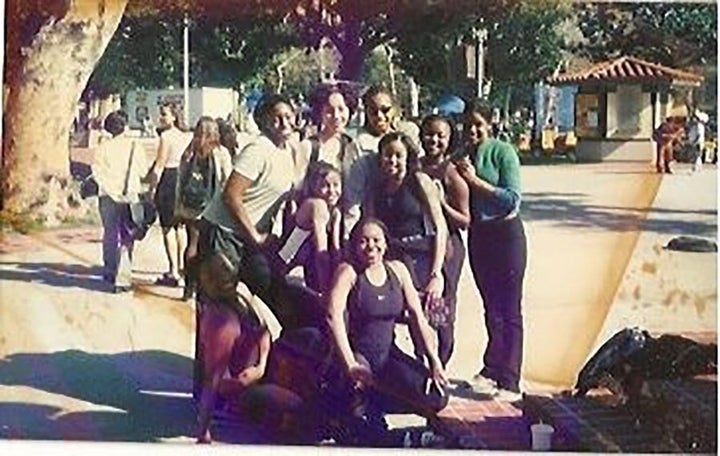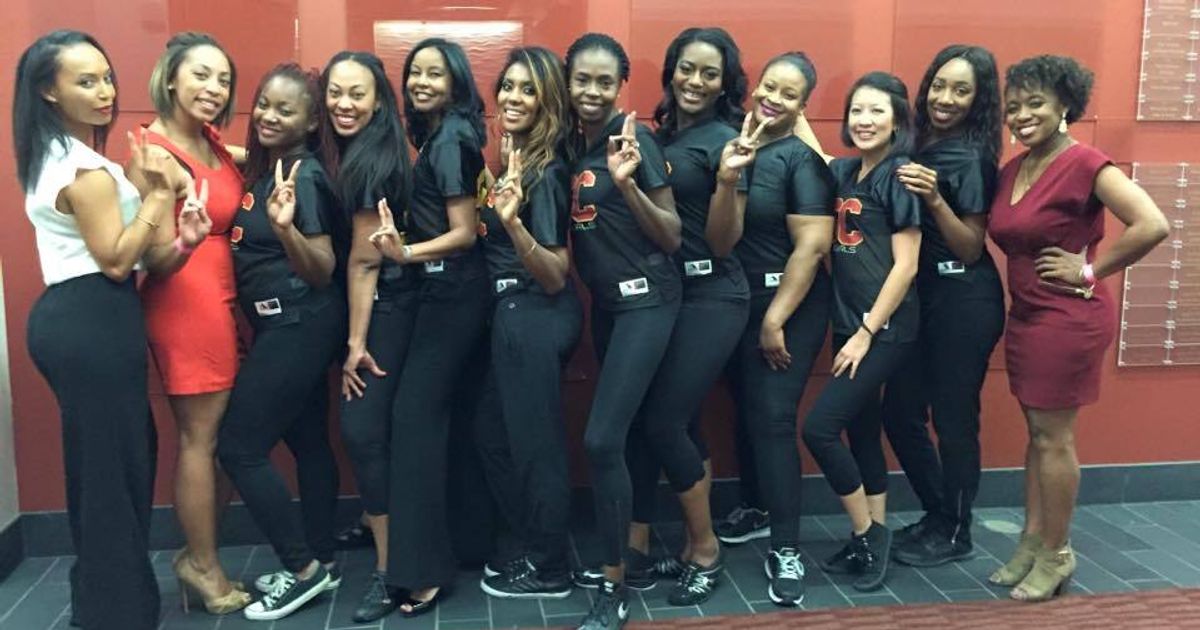Twenty-five years ago, Lisha Bell and Maya Mitchell decided to create their own safe space at the University of Southern California. They wanted to showcase a talent they loved: dance.
Bell and Mitchell were in their sophomore year when they started the USC Fly Girls, named after the dancers from “In Living Color” who were “our sheroes of the ’90s,” Bell said. They had joined other dance teams — Mitchell was a part of the USC Song Girls and Bell danced on the Trojan Dance Force — but they both desired a space to fully express themselves as Black women who dance.
Now, a new team at USC is following in their footsteps. USC’s first Black majorette team, the Cardinal Divas, has already made its mark on campus and continued to educate and captivate its audiences through dance. Since the Cardinal Divas’ viral debut in September, Bell and Mitchell couldn’t be prouder that their legacy is being carried on for the next generation.
“It makes me feel proud,” Bell said. “As an alum, when I see them, it lets me know that Black women are still being seen.”
Bell first learned about the Cardinal Divas in 2021 when team founder Princess Isis Lang, her Delta Sigma Theta sorority sister, mentioned it in their group chat. The Cardinal Divas’ beginnings reminded Bell and several alumni of the Fly Girls’ start.
Bell, who was born and raised in Southern California, always loved to dance. She was a part of her high school’s cheerleading team and met Mitchell, her future college roommate, on a trip to Paris.
“We were both song leaders at our respective high schools and captains as well, so of course, we wanted to carry that tradition into college,” Mitchell said.
When they started at USC in August 1997, Bell and Mitchell auditioned for its most famous dance team, the USC Song Girls, which performed with the school’s marching band.
“We were both going to continue our love for cheer and dance by applying for the USC Song Girls,” Bell said. “But when we got there, reality hit.”
While both Mitchell and Bell applied to be a part of the team, only Mitchell was selected. “I was told by the now-infamous Song Girls coach that I was too hip-y for the skirt,” Bell said. “And from the angle that the viewers watched, there had to be a certain look that the girls needed to have.”
At the time, the USC Song Girls were coached by Lori Nelson, who, according to a Los Angeles Times investigation, has a history of openly discriminating against her athletes. Ten former Song Girls described a “toxic culture” in the dance team, where Nelson “[rebuked] women publicly for their eating habits, personal appearance and sex lives,” Ryan Kartje reported in April 2021.

“I think Black dancers realize that if they are auditioning for a predominantly white squad, they’re probably going to be the only one that makes it,” Mitchell said. “Especially at somewhere like USC, when you look at the history of what their Song Girls look like, many don’t look like us.”
Bell still wanted to be a part of the dance community at USC, so she auditioned for the Trojan Dance Force, which is the official dance team of USC athletics and is known for performing at men’s and women’s basketball games. But she didn’t make it the first time she tried out.
“They already had a Black girl, so I didn’t make the squad until the Black girl graduated,” Bell said.
While USC is located in a predominantly Black and Brown community, the lack of diversity on campus was a shock to Bell. Only 158 students in Bell’s and Mitchell’s freshman class were Black.
“We were frustrated by the idea that only one of us could make one of these squads and that it was always going to be a competition whenever more than one woman of color was auditioning,” Mitchell said.
One of the main reasons that Bell and Mitchell wanted to create the Fly Girls was visibility. Bell wanted Black students and specifically Black women to be seen and celebrated more on campus. Besides the Divine Nine fraternities and sororities, there weren’t many other Black outlets on campus, Bell said. So they strategized in Somerville, a predominantly Black floor in one of the university’s dorms.
Enter the USC Fly Girls, a dance team where Black girls could express themselves freely. Bell and Mitchell made it a point to have women of various shapes, sizes and ethnicities as part of their team. Mitchell said many people have a stereotypical idea of what a dancer is supposed to look like: often white and slender. The Fly Girls wanted to change that narrative and showcase that anyone could be a dancer.
“We were frustrated by the idea that only one of us could make one of these squads and that it was always going to be a competition whenever more than one woman of color was auditioning.”
– Maya Mitchell, a co-founder of the USC Fly Girls
The team had its first performance during Black History Month 1998 in front of the famous Tommy Trojan landmark. “We performed to ‘Rosa Parks’ by OutKast and it felt magical,” Bell said. “We were surrounded by the Black Greeks, and we were just in our circle of love and support. Everyone was cheering, and it felt so good to be seen and celebrated.”
While they received love and support from their fellow students, the Fly Girls faced backlash from some USC administrators.
“We did a dance to Ice Cube’s song ‘We Be Clubbin’’ and that was my jam so you couldn’t tell me nothing,” Bell said. When the performers walked off the basketball court, they received rude comments from coaches and teachers, telling them not to ever dance like that again. “That’s a reality of doing ethnic dances or being too Black in white spaces,” Bell said.
The Fly Girls’ last official performance was in 2008, but the team reunited for a performance in 2015. “We did a Fly Girl reunion, and everyone kept asking what happened to the team,” Bell said. “At the time, there was a movement of competitive dance teams that kind of flourished and then kind of disappeared.”
Competitions such as the World Hip-Hop Dance Championship, which was created in Los Angeles in 2002, helped to publicize hip-hop dance teams. Two years later, the USC Hip-Hop Showcase was created. Teams such as Vanguards Crew, Chaotic 3, iGroove and USC Fly Girls put on biannual performances for students to showcase their skills. Chaotic 3 is still active nearly 20 years later.
“Movement is something that is innate to us. This is not something that can be bottled up,” Bell said. “These are our traditions and we deserve to share them.”
Mitchell said she hopes the Cardinal Divas keep doing what they love, regardless of what others say, and creating a space that’s not only uplifting Black women on campus but also making sure future Black USC students know that a safe haven exists for them on campus.
“We just want to be seen as who we are,” Bell said. “For little young girls who are entering these daunting spaces of minimal diversity, they can see them and know that they can thrive, flourish, be themselves and not have to assimilate to the dominant culture.”
